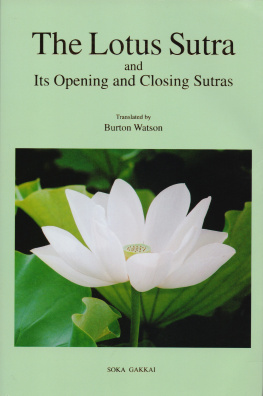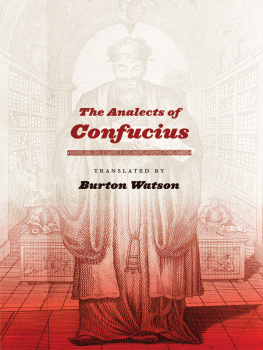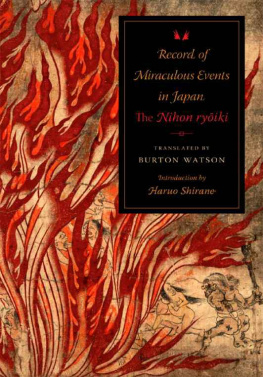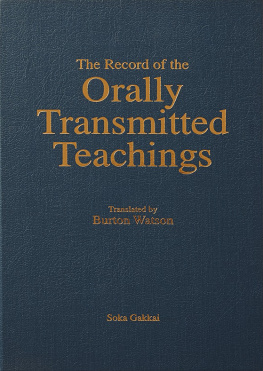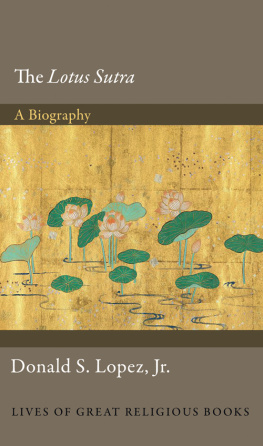Burton Watson - The Lotus Sutra and Its Opening and Closing Sutras
Here you can read online Burton Watson - The Lotus Sutra and Its Opening and Closing Sutras full text of the book (entire story) in english for free. Download pdf and epub, get meaning, cover and reviews about this ebook. year: 2009, publisher: Soka Gakkai, genre: Religion. Description of the work, (preface) as well as reviews are available. Best literature library LitArk.com created for fans of good reading and offers a wide selection of genres:
Romance novel
Science fiction
Adventure
Detective
Science
History
Home and family
Prose
Art
Politics
Computer
Non-fiction
Religion
Business
Children
Humor
Choose a favorite category and find really read worthwhile books. Enjoy immersion in the world of imagination, feel the emotions of the characters or learn something new for yourself, make an fascinating discovery.
- Book:The Lotus Sutra and Its Opening and Closing Sutras
- Author:
- Publisher:Soka Gakkai
- Genre:
- Year:2009
- Rating:3 / 5
- Favourites:Add to favourites
- Your mark:
- 60
- 1
- 2
- 3
- 4
- 5
The Lotus Sutra and Its Opening and Closing Sutras: summary, description and annotation
We offer to read an annotation, description, summary or preface (depends on what the author of the book "The Lotus Sutra and Its Opening and Closing Sutras" wrote himself). If you haven't found the necessary information about the book — write in the comments, we will try to find it.
The Lotus Sutra and Its Opening and Closing Sutras — read online for free the complete book (whole text) full work
Below is the text of the book, divided by pages. System saving the place of the last page read, allows you to conveniently read the book "The Lotus Sutra and Its Opening and Closing Sutras" online for free, without having to search again every time where you left off. Put a bookmark, and you can go to the page where you finished reading at any time.
Font size:
Interval:
Bookmark:
Burton Watson
2009
F rom early times the Lotus Sutra has been known as the king of the sutras. This is above all because it is a scripture of great hope that brings light to the hearts of all people.
The Lotus Sutra clearly and definitively reveals the buddha nature that is an integral part of the lives of all people. And it makes clear that the Buddha desires and acts so that all people, by opening up this buddha nature inherent within themselves, may attain the state of buddhahood for themselves. The sutra further stresses that the continued observance of such action is the true mission of the bodhisattva, and never ceases to praise the observance of this practice.
The buddha nature, which is inherent in all living beings, is a universal and fundamental source or fountain of hope. When it is fully brought to light, it allows all human beings to realize their highest level of personal development and to attain unparalleled happiness and good fortune. And the Lotus Sutra is the text that most forcefully asserts this truth.
The Lotus Sutra, which possesses the power to fulfill the hopes latent in the lives of human beings, spread from India to Central Asia, and from there to the countries of eastern Asia. In India and Central Asia various manuscripts of the sutra in Sanskrit and other languages of that area into which it was translated have been found. In the region of eastern Asia, it was translated into Chinese by Kumarajiva (344413), and that is the version in which it has been read, recited, and best known by many people. In that form, we may say, it constituted one of the most important spiritual elements underlying the culture of China in the Six Dynasties, Sui, and Tang periods, and of Japan in the Heian period.
In particular, in China in the sixth century the Great Teacher Tiantai (538597), on the basis of the Lotus Sutra, developed his system of interpretation known as three thousand realms in a single moment of life, which expounds the philosophy of hope embodied in the Lotus Sutra in a subtle and logically convincing manner. But although there had been, in the history of the transmission of the Lotus Sutra, efforts to transcend the barrier of cultural differences and bring out the universally valid nature of the sutras message, it would appear that the true worth of the Lotus Sutra had not, in this period before the appearance of Nichiren Daishonin (12221282), as yet been fully revealed.
Nichiren Daishonin in his writings states: The heart of the Buddhas lifetime of teachings is the Lotus Sutra, and the heart of the practice of the Lotus Sutra is found in the Never Disparaging chapter. What does Bodhisattva Never Disparagings profound respect for people signify? The purpose of the appearance in this world of Shakyamuni Buddha, the lord of teachings, lies in his behavior as a human being ( The Writings of Nichiren Daishonin, vol. 1, pp. 85152).
By this the Daishonin means that the heart of the Lotus Sutra, the highest among all of Shakyamunis teachings, resides in the practice carried out by Bodhisattva Never Disparaging of respecting and paying reverence to all people. The life of each and every person is endowed with the buddha nature, the seed or potential for attaining buddhahood. So long as a person pursues the correct path, this seed will invariably sprout, blossom, and bear fruit. It was on the basis of this firm conviction that Bodhisattva Never Disparaging paid obeisance to every single person that he encountered.
To encourage and bring to fulfillment this practice of paying respect to others, we may say, constitutes the Buddhas basic aim, the true message of the Lotus Sutra, and the true propagation of the Lotus Sutra. In order to achieve the ideals and spirit of the Lotus Sutra, Nichiren Daishonin made this most important practice the very core of his being. Moreover, he revealed Nam-myoho-renge-kyo of the Three Great Secret Laws as the manifestation of his own life embodying the buddha nature, and for the sake of all people of the future, opened up the path that would lead to inner transformation, or human revolution, and the creation of a peaceful and ideal society.
In the seventy-nine years since its founding in 1930, the Soka Gakkai, obeying the final instructions of Nichiren Daishonin, has wholeheartedly carried out this most important practice of the Lotus Sutra. As individuals among the populace have succeeded in attaining their own personal victory and realized full satisfaction in life, a rich human culture has blossomed into being, and a path has been opened for the establishment of world peace. And this path is now being spread throughout the entire globe.
For humankind as a whole, the twenty-first century represents the crucial, the now-or-never moment for the establishment of peace. Therefore I firmly believe that now is the time to work more tirelessly than ever to propagate and establish this philosophy of hope set forth in the Lotus Sutra, a scripture that delves into the very fundamentals of human life, and that this opportunity must not be missed. For that reason it is with profound joy that, at the start of this, the twenty-first century, I greet the publication of this Soka Gakkai edition of The Lotus Sutra and Its Opening and Closing Sutras as it makes its way out into the world.
I would like in conclusion to express my thanks to Dr. Burton Watson for his painstaking English translation of the three sutras.
Daisaku Ikeda
President of Soka Gakkai International
See Glossary.
T he present volume offers an English translation of the Lotus Sutra, and of two short sutras, the Immeasurable Meanings Sutra and the Sutra on How to Practice Meditation on Bodhisattva Universal Worthy, that have traditionally been regarded as the opening and closing sutras for the Lotus. The Lotus Sutra translation, done by Burton Watson, renowned translator of many works of classical Chinese and Japanese literature, was originally published in 1993 by Columbia University Press. It appears here in slightly revised form. The translations of other two accompanying sutras, also by Burton Watson, appear here for the first time.
All the translations conform to the Chinese texts of these sutras as they appear in Myh-renge-ky narabini kaiketsu (The Lotus Sutra of the Wonderful Law and Its Opening and Closing Sutras), published in 2002 by the Soka Gakkai. Tiantai (538597), or Zhiyi, founder of the Tiantai school of Buddhism in China, considered the three sutras a single unit, thus establishing the tradition in which they have been called over the centuries the threefold Lotus Sutra. Nichiren (12221282), the Japanese Buddhist scholar-monk whose teachings the Soka Gakkai practices, also held this view. The Myh-renge-ky narabini kaiketsu is based upon the texts of the three sutras that Nichiren used to instruct his disciples and write his own works. Called the Ch Hokeky, or the Annotated Lotus Sutra, it includes related passages from the works of Tiantai and other scholar-monks that Nichiren noted down for his own reference.
With regard to the two short sutras, a few remarks may be in order.
According to Chinese records, the Immeasurable Meanings Sutra was translated into Chinese in 481 by Dharmagathayashas, a monk from central India. We have no knowledge of what language Dharmagathayashas translated the sutra from, and some scholars now suggest that it may actually have been first composed in Chinese.
The sutra, made up of three chapters, describes Shakyamuni Buddha preaching on Eagle Peak. Chapter one, entitled Virtuous Practices, praises the Buddha and his various characteristics. Chapter two, Preaching the Law, explains that all the teachings and their immeasurable meanings derive from a single Law, and that those teachings preached during the first forty years and more of the Buddhas teaching life do not reveal the truth. Chapter three, Ten Benefits, describes the benefits that practitioners of the sutra will gain.
Font size:
Interval:
Bookmark:
Similar books «The Lotus Sutra and Its Opening and Closing Sutras»
Look at similar books to The Lotus Sutra and Its Opening and Closing Sutras. We have selected literature similar in name and meaning in the hope of providing readers with more options to find new, interesting, not yet read works.
Discussion, reviews of the book The Lotus Sutra and Its Opening and Closing Sutras and just readers' own opinions. Leave your comments, write what you think about the work, its meaning or the main characters. Specify what exactly you liked and what you didn't like, and why you think so.

